
Stainless steel tubing plays a pivotal role in various industries, offering a balance of durability, corrosion resistance, and affordability. Among the plethora of stainless steel grades available, 409 stainless steel tubing emerges as a versatile solution for numerous applications. In this in-depth exploration, we’ll delve into the characteristics, applications, benefits, and considerations surrounding 409 stainless steel tubing, providing valuable insights for engineers, manufacturers, and enthusiasts alike.
Understanding 409 Stainless Steel Tubing: 409 stainless steel belongs to the ferritic stainless steel family, characterized by its chromium content and low carbon composition. This alloy offers notable corrosion resistance, weldability, and formability, making it a sought-after material for diverse industrial applications.
Characteristics of 409 Stainless Steel Tubing: Corrosion Resistance: 409 stainless steel tubing exhibits commendable resistance to corrosion, particularly in mildly corrosive environments such as automotive exhaust systems and outdoor structures. Its chromium content forms a protective oxide layer, enhancing longevity and durability in challenging conditions.
Heat Resistance:
While not as heat resistant as austenitic stainless steel grades, 409 stainless steel tubing performs admirably at moderate temperatures. This makes it suitable for applications such as heat exchangers and boiler tubes where exposure to elevated temperatures is anticipated.
Weldability:
One of the standout features of 409 stainless steel tubing is its exceptional weldability. It can be seamlessly welded using common techniques like MIG, TIG, and resistance welding without encountering brittleness or cracking, facilitating ease of fabrication and assembly.
Formability:
Due to its low carbon content and ferritic structure, 409 stainless steel tubing demonstrates good formability. Manufacturers can shape, bend, and manipulate the tubing to create intricate designs and configurations, expanding its utility across various industries.
Applications of 409 Stainless Steel Tubing:
Automotive Exhaust Systems: 409 stainless steel tubing finds extensive use in automotive exhaust systems, where its corrosion resistance, heat resistance, and weldability are highly valued. It withstands the corrosive effects of engine exhaust gases and environmental factors, ensuring longevity and reliability in demanding conditions.
Heat Exchangers and Boiler Tubes: In industrial settings, 409 stainless steel tubing serves in heat exchangers, boiler tubes, and process piping applications. Its corrosion resistance and moderate heat resistance make it suitable for conveying fluids and gases at elevated temperatures while maintaining structural integrity.
Structural Components and Architectural Elements: In architectural and construction applications, 409 stainless steel tubing may be employed for structural components, handrails, and decorative elements. Its corrosion resistance and affordability make it an attractive option for outdoor structures and interior design elements.
Outdoor Furniture and Railing Systems: Due to its corrosion resistance and durability, 409 stainless steel tubing is favored for outdoor furniture, railing systems, and other structures exposed to environmental elements. It withstands weathering and maintains its aesthetic appeal over prolonged periods.
Benefits of 409 Stainless Steel Tubing: Cost-Effectiveness: One of the primary advantages of 409 stainless steel tubing is its cost-effectiveness. It offers excellent corrosion resistance and durability at a more affordable price point compared to other stainless steel grades, making it an economical choice for various applications.
Corrosion Resistance: 409 stainless steel tubing provides reliable resistance to corrosion, ensuring longevity and performance in harsh environments. Its chromium content forms a protective layer that shields the material from corrosive agents, extending its service life.
Weldability and Fabrication Ease: The weldability of 409 stainless steel tubing allows for easy fabrication and assembly, reducing manufacturing time and costs. Manufacturers can efficiently weld and manipulate the tubing to meet specific design requirements without compromising structural integrity.
Versatility: With its commendable corrosion resistance, heat resistance, weldability, and formability, 409 stainless steel tubing offers versatility across a spectrum of applications. It caters to diverse industry needs, from automotive and industrial sectors to architectural and outdoor settings.
Considerations for 409 Stainless Steel Tubing:
While 409 stainless steel tubing offers numerous benefits, there are certain considerations to keep in mind:
Temperature Limitations: Due to its ferritic structure, 409 stainless steel tubing has temperature limitations compared to austenitic stainless steel grades. It may not be suitable for applications requiring high-temperature resistance beyond its specified range.
Environmental Exposure: While corrosion-resistant, 409 stainless steel tubing may still experience corrosion in highly aggressive environments such as marine or chemical processing settings. Proper maintenance and protective coatings may be necessary to mitigate corrosion risks.
Conclusion:
n conclusion, 409 stainless steel tubing emerges as a versatile and cost-effective solution for a myriad of applications across industries. Its commendable corrosion resistance, weldability, and formability make it a preferred choice for automotive exhaust systems, heat exchangers, architectural elements, and outdoor structures. By understanding its characteristics, applications, benefits, and considerations, stakeholders can harness the full potential of 409 stainless steel tubing in their respective domains, paving the way for innovation and efficiency.










